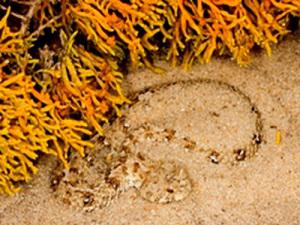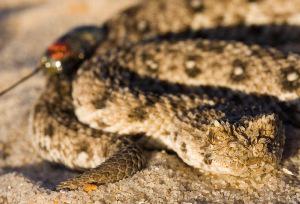Bryan Maritz
Other projects
29 Jan 2014
Identifying Target Species for Wildlife Conservation in South Africa – Implications for Sustainable Biodiversity Use
This project aims to improve our knowledge of the biology and habitat requirements of the threatened Namaqua Dwarf Adder (Bitis schneideri).

The Namaqua Dwarf Adder is listed as Vulnerable by the IUCN. Little is known of its biology.
The Namaqua Dwarf Adder (Bitis schneideri) is the world's smallest adder, and is endemic to southern Africa. The species is listed as Vulnerable by the IUCN, but could equally be listed as Data Deficient given the paucity of information on its ecology and conservation biology. This paucity of information demands attention if the species is to be adequately managed within its transforming habitat. The Namaqua Dwarf Adder faces several threats. Most prominent among these is habitat loss resulting from diamond mining activities that are widespread within the species' limited geographic range. Additionally, the Namaqua Dwarf Adder is threatened by illegal collection for the pet trade. Finally, global climate change presents unknown but potentially significant threat to the species, particularly given its location within the Succulent-Karoo Biome. This project arose in recognition of the threats facing this species and others within the region. It is hoped that information gathered during the course of this project will help to identify suitable habitat for the species and motivate for the protection of such habitats.

NDA fitted with radio transmitter.
Primarily, this project hopes to identify the habitat and ecological requirements of the species. Without this information, any efforts to save the species from extinction are prone to being misguided and could potentially fail. Secondly, conservation of Namaqua Dwarf Adder habitat, resulting from the efforts of this project, would result in the preservation of habitats important to other threatened species in the area (of which there are numerous plant and animal species).
As part of the project, an intensive mark-recapture study has been initiated. This component aims to estimate population size, growth and age structure of the population being studied. It involves actively searching for specimens, then marking them, collecting an array of biometric measurements, recording habitat traits, and releasing the specimen. These data are essential as they will inform us as to population size, age structure, and potential fluctuations in Namaqua Dwarf Adder population numbers.
A radio-telemetry study is also being planned as a critical component of this project. This component will allow us to estimate home-range size and other movement parameters, quantify microhabitat utilisation, and collect valuable natural history observations. The radio-telemetry study will involve gluing tiny (<0.8g) radio transmitters to the body of study animals. These transmitters will emit a signal that will allow for the daily location of these cryptic animals.